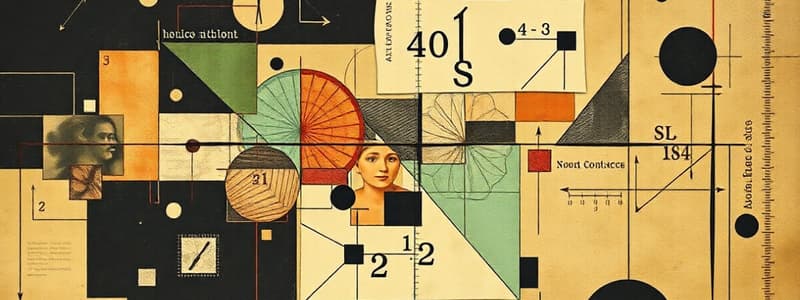Podcast
Questions and Answers
What is the result of the equation $2x + 3 = 7$ when solving for $x$?
What is the result of the equation $2x + 3 = 7$ when solving for $x$?
- 2 (correct)
- 3
- 1
- 4
Which of the following is an example of a prime number?
Which of the following is an example of a prime number?
- 4
- 6
- 11 (correct)
- 9
In basic probability, how is the probability of an event $A$ calculated?
In basic probability, how is the probability of an event $A$ calculated?
- 1
- 0 (correct)
- 35
- 45
What represents the measure of how a function changes as its input changes in calculus?
What represents the measure of how a function changes as its input changes in calculus?
Which of the following statements about independent events is true?
Which of the following statements about independent events is true?
What is the relationship expressed by the Pythagorean Theorem?
What is the relationship expressed by the Pythagorean Theorem?
Which of the following is NOT a valid type of average in statistics?
Which of the following is NOT a valid type of average in statistics?
Flashcards are hidden until you start studying
Study Notes
Key Concepts in Mathematics
1. Basic Arithmetic
- Addition: Combining two or more numbers (e.g., 2 + 3 = 5).
- Subtraction: Finding the difference between numbers (e.g., 5 - 2 = 3).
- Multiplication: Repeated addition of a number (e.g., 4 x 3 = 12).
- Division: Splitting a number into equal parts (e.g., 12 ÷ 3 = 4).
2. Algebra
- Variables: Symbols used to represent unknown values (e.g., x, y).
- Equations: Mathematical statements that two expressions are equal (e.g., 2x + 3 = 7).
- Functions: Relationships between sets that assign each input exactly one output (e.g., f(x) = 2x + 3).
3. Geometry
- Shapes: Basic figures (e.g., squares, circles, triangles).
- Perimeter: Total distance around a shape.
- Area: Measure of the space inside a shape (e.g., Area of a rectangle = length x width).
- Volume: Measure of space inside a 3D object (e.g., Volume of a cube = side³).
4. Trigonometry
- Sine, Cosine, Tangent: Ratios derived from the angles of a right triangle.
- Pythagorean Theorem: a² + b² = c², relates the lengths of the sides of a right triangle.
5. Calculus
- Limits: The value that a function approaches as the input approaches a point.
- Derivatives: Measure of how a function changes as its input changes (slope of a curve).
- Integrals: Represents the accumulation of quantities and the area under a curve.
6. Statistics
- Mean: Average value of a set of numbers.
- Median: Middle value when data is ordered.
- Mode: Most frequently occurring value in a dataset.
- Standard Deviation: Measure of the amount of variation or dispersion in a set of values.
7. Probability
- Basic Probability: Likelihood of an event occurring, calculated as favorable outcomes over total outcomes (P(A) = Number of favorable outcomes / Total outcomes).
- Independent Events: Events where the occurrence of one does not affect the other.
- Dependent Events: Events where the occurrence of one affects the probability of the other.
8. Number Theory
- Prime Numbers: Natural numbers greater than 1 with no positive divisors other than 1 and themselves.
- Factors: Numbers that divide another number evenly.
- Multiples: The result of multiplying a number by an integer.
9. Mathematical Modeling
- Functions: Use mathematical equations to represent real-world situations.
- Graphs: Visual representations of functions and data.
Study Tips
- Practice problems regularly to solidify understanding.
- Use visual aids like graphs and charts to comprehend concepts better.
- Explore real-world applications to see the relevance of mathematical theories.
- Group study sessions can enhance problem-solving skills through collaboration.
Basic Arithmetic
- Addition combines two or more numbers, such as 2 + 3 resulting in 5.
- Subtraction determines the difference between numbers, as shown in 5 - 2 = 3.
- Multiplication entails repeated addition of a number, for example, 4 x 3 equals 12.
- Division divides a number into equal parts, exemplified by 12 ÷ 3 resulting in 4.
Algebra
- Variables are symbols representing unknown values, commonly x and y.
- Equations express that two expressions are equal, illustrated by 2x + 3 = 7.
- Functions define a relationship assigning each input exactly one output, like f(x) = 2x + 3.
Geometry
- Shapes include basic figures such as squares, circles, and triangles.
- Perimeter calculates the total distance around a shape.
- Area quantifies the space within a shape; for instance, the area of a rectangle is found using length x width.
- Volume measures the space inside a three-dimensional object; the volume of a cube is calculated as side³.
Trigonometry
- Sine, cosine, and tangent are ratios derived from the angles of a right triangle.
- The Pythagorean Theorem, stated as a² + b² = c², links the lengths of a right triangle's sides.
Calculus
- Limits define the value a function approaches as its input nears a specific point.
- Derivatives measure how a function changes in relation to changes in its input, representing the slope of a curve.
- Integrals indicate the accumulation of quantities or the area under a curve.
Statistics
- Mean is the average value derived from a set of numbers.
- Median signifies the middle value when data points are sorted.
- Mode refers to the most frequently occurring value within a dataset.
- Standard deviation gauges the variation or dispersion present in a set of values.
Probability
- Basic probability assesses the likelihood of an event happening, calculated as the ratio of favorable outcomes to total outcomes (P(A) = Number of favorable outcomes / Total outcomes).
- Independent events occur independently, meaning one event's occurrence does not influence the other.
- Dependent events' occurrence affects the probability of the other event happening.
Number Theory
- Prime numbers are natural numbers greater than 1 that have no divisors other than 1 and themselves.
- Factors are numbers that divide another number evenly.
- Multiples result from multiplying a number by an integer.
Mathematical Modeling
- Functions utilize mathematical equations to depict real-world situations.
- Graphs serve as visual representations of functions and data.
Study Tips
- Regular practice of problems strengthens comprehension.
- Visual aids, including graphs and charts, enhance understanding of concepts.
- Examining real-world applications demonstrates the relevance of mathematical theories.
- Collaborative group study sessions improve problem-solving skills through teamwork.
Studying That Suits You
Use AI to generate personalized quizzes and flashcards to suit your learning preferences.




